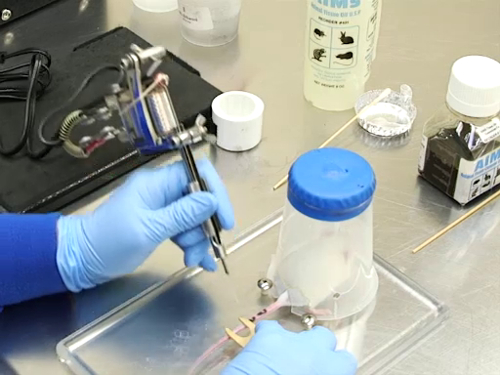0:00
Overview
1:06
Considerations for Identification Methods
3:40
Tail Tattooing in Adults
6:24
Toe Tattooing in Neonates and Adults
9:16
Microchip Placement
10:24
Method for Temporary Identification
11:21
Applications
13:00
Summary
Rodent Identification II
Source: Kay Stewart, RVT, RLATG, CMAR; Valerie A. Schroeder, RVT, RLATG. University of Notre Dame, IN
Animal records must be accurately maintained to ensure that data collection is correct. Records range from maintaining information on cage cards to having a detailed database with all of the relevant information on each animal. The primary component of recordkeeping is the individual identification of research animals. There are a variety of methods suitable for identifying mice and rats. This video describes the procedural techniques for tattooing, microchip placement, and temporary identification methods, and also explores the benefits of each.
1. Tail tattoo
Tail tattoos are easily read without the need to handle the animal.

Figure 1. Tail tattooing on adult mice
- Prepare the tattoo equipment according to the manufacturer's instructions. A small amount of ink is required. Black dye should be used for albino mice or rats, and green dye for pigmented mice or rats. <
When choosing the appropriate identification method, many factors must be deliberated. Each technique has advantages and disadvantages that must be considered in relation to experimental needs. While the costs must be weighed along with other factors, the ease of the technique and the level of discomfort to the animals should be the primary considerations.4,5
- Robinson, V., Morton, D.B., Anderson, D., Carver, J.F.A., Francis, R.J., Hubrecht, R., Jenkins, E., Mathers, K.E., Raymond, R., Rosewell, I., Wallace, J., and Wells, D.J. 2003. Refinement and reduction in production of genetically modified mice. Laboratory Animals. 37:S1-S50.
- Schaefer, D.C., Asner, I.N., Seifert, B., Bürki, K., and Cinelli, P. 2010. Analysis of physiological and behavioural parameters in mice after toe clipping as newborns. Laboratory Animals. 44:7-13
- Castelhano-Carlos, M.J., Sousa, N., Ohl, F., and Baumans, V. 2010. Identification methods in newborn C57BL/6 mice: a developmental and behavioural evaluation. Laboratory Animals. 44: 88-103.
- Danneman, P.J., Suckow, M.A., and Brayton, C.F. 2013. The laboratory mouse. Second edition. New York, NY: CRC Press.
- Institute for the Laboratory Animal Research. 2011. Guide for the care and use of laboratory animals, 8th ed. Washington (DC): National Academies Press.
ABOUT JoVE
Copyright © 2024 MyJoVE Corporation. All rights reserved